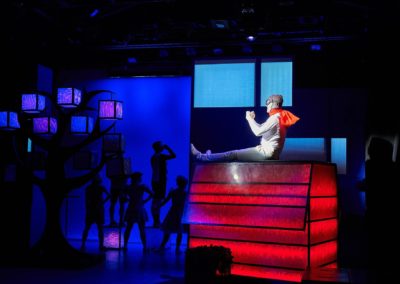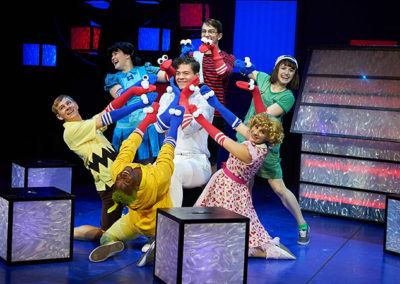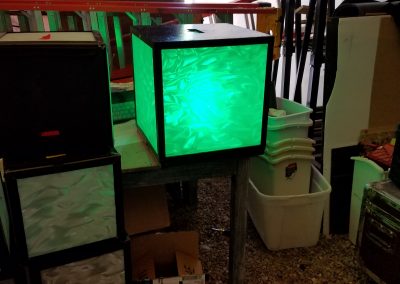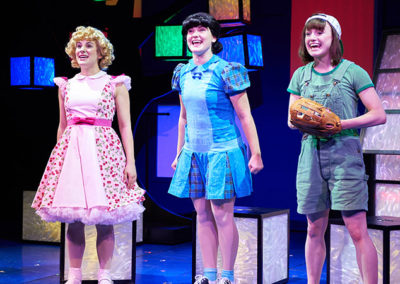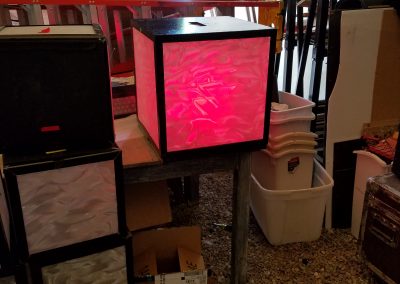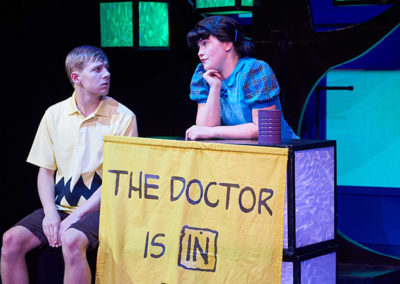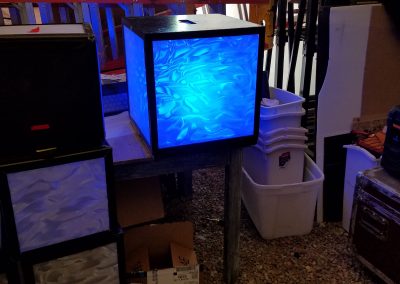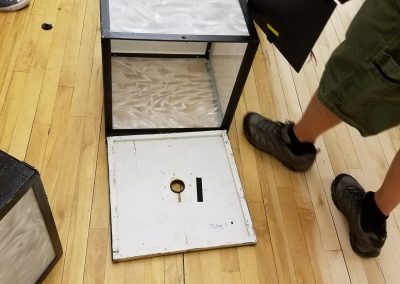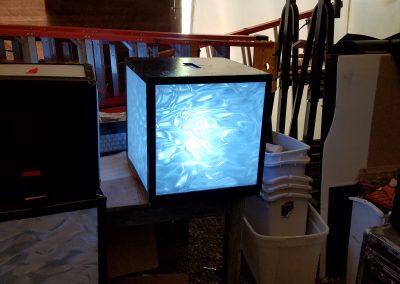When ‘The World of Snoopy’ took to the stage last summer at Theatre Aspen, the design team had a challenge: find a way to create wireless illuminated boxes and an LED doghouse that didn’t wash out on stage. “The original design concept all came from the idea of the Peanut squares; cartoons exist in these little squares that you read across, so the background was a series of squares that would light up. they just weren’t bright enough as far as we were concerned,” explains Lighting Designer Paul Black.
‘The World of Snoopy’ was comprised of 20 different vignettes that played out in two acts. “It introduced all of the regular Peanuts characters, and like the Peanuts strip, it had little sections that were lifted from the original cartoon. There wasn’t a plot line; the only consistent theme was Snoopy. There was Snoopy’s Red Baron moment, Snoopy’s writing moment, and then you’d cut to various things, like Sally at school, there were Charlie Brown and Lucy as a psychologist; it had all of those classic Peanuts moments,” says Black.
Each Peanuts character had a box and an assigned color; however, when a box left a character, it would change color. Black explains: “The characters started the show standing on top of their box; they’d get a special on their face and their spots; after that, all bets were off. For example, when Linus did his song about the Great Pumpkin, all of the boxes were piled around Linus, and we lit them orange, so they all looked like pumpkins.” In another scene, Woodstock t made a nest out of several boxes, and they turned yellow. “It was a two-hour show, so it was important that they could last two hours and be lit, but had also had to be bright enough, because it’s a cartoon. It couldn’t be dark and moody lighting, it had to be really bright,” Black adds.
The RC4 DMX4dim was key to making the boxes work. “When the set and props arrived at Theater Aspen – it originally started at Texas State – it was sort of dim. We rebuilt the LED cores and RC4 products were the dimming solution,” says Black.
Lighting Supervisor Colin Riebel used some technical magic to make the boxes stage ready. “The cores are something that I’ve seen done a lot with RC4 gear—you’re wrapping LED tape over a PVC center and putting the battery and the RC4 unit inside all of that. Colin was able to maximize that tape and the RC4 dimmer to get the blocks to actually be bright enough to see them,” Black adds.
There were six boxes that used during the show. “Each box had either a 10” or 12” PVC pipe that was wrapped with standard 12 volt RGB LED tape, and that went into the RC4 DMX4dim unit. Underneath that was an end cap for a drainage pipe; that’s what I secured the battery to; the DMX4dim sat on top of the battery with a power switch and a charging port. That whole assembly then got bolted to the bottom of the interior of the box, so the assembly would not move at all. So the performers were able to pick the boxes up, flip them upside down, put them where they needed them to, and the core stayed in the center,” explains Riebel.
The boxes were actually a magical part of the production. Riebel says: “While we’ve done stuff with LEDs before, there was a lot more magic in how they were used; it was a very tactile thing. Every time a performer moved or touched a box, it would change to a different color” Black adds, “This was a fun use of RC4 units because of all of the color changing and to use it in an interactive kind of way; the interplay of color helped tell the story, which then helped her tell the story of this new musical.”
There were a total of six RC4Magic Series 3 SX DMX4dims used for the boxes; however, the boxes weren’t the only pieces to use the RC4 equipment. “The doghouse was made out of the same Plexiglas as the boxes; it got pushed all over the place and it also had to light up. It only lit red, and it was really dim when it arrived,” notes Black.
Riebel explains what he did to make Snoopy’s doghouse pop: “The big problem was that it was red and needed to be bright enough to be seen with all the stage lights on and be on the entire time. We lined it with 15 meters of red LED tape, and then split up over four channels on one RC4 DMX4dim dimmer. I had two big motorcycle batteries inside the doghouse powering it all, so we were able to run it for the entire show. Inside Snoopy’s doghouse; we built a little wooden box that hid the two batteries, and the dimmer. It also had a power switch and a charge port. So it was a self-contained unit that was built for the interior of the doghouse.”
The budget was also a consideration for the projection. “When we started talking about this project, we knew about RC4 and we had the RC4 solution that I was able to say ‘Yes, definitely, we can do this. Let’s go down this road. We can make this happen,’ and that was really exciting. It’s always nice to say ‘yes, we can do this.’ If we had to do this using City Theatrical equipment, we couldn’t have done it because we couldn’t afford it; it also would have been too heavy and too big,” notes Black.
Both Black and Riebel are longtime RC4 users. “I love RC4 equipment. It’s one of my favorite things to work with, especially for these type of projects. I love working with LEDs, and the RC4 products are easy to use with them. I’m a huge fan and proponent of RC4,” says Riebel. Black adds, “We love RC4 units; we put it on lots of shows, we recommend them and tell our theaters to purchase them.”
‘The World of Snoopy,’ which is licensed by the estate of Charles Schultz, has been performed in three different theaters. “They want to send it out on tour; if they do, there will be even more RC4 Wireless gear on it,” Black concludes.
